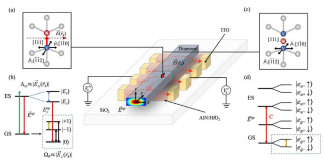News
Field programmable spin arrays for scalable quantum repeaters
In the progress report, it was noted that for “quantum computational advantage” in harnessing many-body quantum stages with spins, large scale control over thousands of spin qubits and their interaction was needed, but was limited by power consumption and cross-talk inherent in current microwave techniques. To this end, we analyzed the problem from first principles in terms of what spin control would allow large numbers of qubits to be controlled with low cross – talk and low heating. Based on this study, we proposed an architecture based on densely-packed diamond color centers (CCs) in a programmable electrode array. We call this architecture the ‘electric-field programmable spin array’ (eFPSA), which enables high-speed spin control of individual CCs with low cross-talk and power dissipation. We specifically modeled the eFPSA in a slow-light waveguide for efficient optical coupling and served as a quantum interface for optically-mediated entanglement. The performance of the eFPSA architecture was evaluated in comparison to a routing tree design and showed increased entanglement generation rate into thousands of qubits regime. The results enabled high fidelity control of dense quantum emitter arrays for scalable networking.

An exemplary FPSA implementation. A diamond waveguide (gray) containing CCs is positioned on an array of high-index dielectric fins (red) between ITO electrodes (yellow) connected to a voltage supply.
To disseminate this result to a broader audience, Prof Englund wrote the following soliloquy (pre-chat GPT):
The soliloquy of the Quantum Engineer faced with controlling many electron spins on a chip:
“Use B or E, that is the question:
Whether ’tis nobler on the chip to suffer
The slings and arrows of outrageous gate errors,
Or to take Arms against a Sea of magnetic cross-talk,
And by tiny E-fields, confine them?
To B or not to B?”
